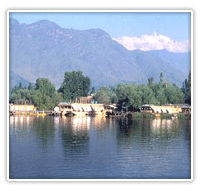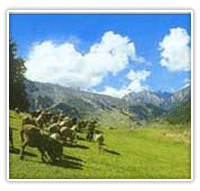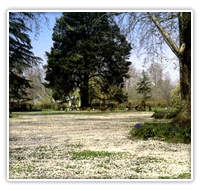|
|
|
|
|
|
|
Home » Hill
Stations in India » Hill Stations in Jammu &
Kashmir » Kashmir
|
|
|
|
Kashmir
|
|
|
|
 Set
like a jewelled crown on the map of India, Kashmir is a
multi-faceted diamond, changing its hues with the seasons -
always extravagantly beautiful. Two major Himalayan ranges,
the Great Himalayan Range and the Pir Panjal, surround the
landscape from the north and south respectively. They are
the source of great rivers, which flow down into the
valleys, forested with orchards and decorated by lily-laden
lakes. Set
like a jewelled crown on the map of India, Kashmir is a
multi-faceted diamond, changing its hues with the seasons -
always extravagantly beautiful. Two major Himalayan ranges,
the Great Himalayan Range and the Pir Panjal, surround the
landscape from the north and south respectively. They are
the source of great rivers, which flow down into the
valleys, forested with orchards and decorated by lily-laden
lakes.
The Mughals aptly called Kashmir ‘Paradise on Earth’
where they journeyed across the hot plains of India, to the
valley’s cool environs in summer. Here they laid, with
great love and care, Srinagar’s many formal, waterfront
gardens, now collectively known as the Mughal Gardens.
Anecdotes of four and five centuries ago describe their love
for these gardens, and the rivalries that centred around
their ownership. They also patronized the development of art
& craft among the people of Kashmir, leaving behind a
heritage of exquisite artisanship among thes people and
making the handicrafts of the land prized gifts all over the
world.
Kashmir is famous for its natural beauty and has often been
referred to as the 'Switzerland of the East'. The heart of
the area is the fertile Vale of Kashmir (known as The
Valley), which lies between the Himalayas and the Pir Panjal
mountain range. Here the climate is mild and the soil well
watered. A large part of Jammu & Kashmir state forms
part of the Himalayan mountains. A major portion of Jammu
& Kashmir State consists of the western Himalayas, which
besides many lofty mountain ranges with varying heights of
3000 to 6000 metres and above, also abound in rivers, lakes,
passes, glaciers, plateaus and plains. The number of
streams, brooks, hill torrents and rivers is also fairly
large. The most important rivers in the Jammu & Kashmir
are the Indus, Chenab, Jehlum and Ravi, which irrigates the
land through out the year. The state of Jammu & Kashmir
is geologically constituted of rocks varying from the oldest
period of the earth’s history to the youngest present day
river and lake  deposits.
The rich flora of Jammu & Kashmir shelters a large
number of rare and endangered species, rare to find
elsewhere. deposits.
The rich flora of Jammu & Kashmir shelters a large
number of rare and endangered species, rare to find
elsewhere.
Kashmir is a land where myriad holiday ideas are realised.
In winter, when snow carpets the mountains, there is skiing,
tobogganing, sledge-riding, etc. along the gentle slopes. In
spring and summer, the honey-dewed orchards, rippling lakes
and blue skies beckon every soul to sample the many delights
the mountains and valleys have to offer. Golfing at 2,700 m
above the sea, water-skiing in the lakes and angling for
prized rainbow trout, or simply drifting down the willow
fringed alleys of lakes in shikaras and living in gorgeous
houseboats are some of the most favoured ones.
Shalimar Gardens in autumn
The onset of autumn, perhaps Kashmir's loveliest season, is
towards September, when green turns to gold and then to
russet and red. The highest day temperatures in September
are around 23oC and night temperatures dip to 10oC by
October, and further drop by November, when heavy woollens
are essential.
Kashmir
Valley in winter
Through
December, to the beginning of March is winter time, which
presents Srinagar in yet another mood. Bare, snow-covered
landscapes being watched from beside the warmth of a fire is
a joy that cannot be described to anyone who has not
experienced it. Some houseboats and hotels remain open in
winter-these are either centrally heated or heated  with
‘bukharis’, a typically Kashmiri stove kept alight with
embers of wood, quite effective in the winter. with
‘bukharis’, a typically Kashmiri stove kept alight with
embers of wood, quite effective in the winter.
SEASON
In summer, daisies carpet parks and gardens all over Kashmir
Kashmir has four distinct seasons, each with its own
peculiar character and distinctive charm. These are spring,
summer, autumn and winter. Spring, which extends roughly
from March to early May, is when a million blossoms carpet
the ground. The weather during this time can be gloriously
pleasant at 23oC or chilly and windy at 6oC. This is the
season when Srinagar experiences rains, but the showers are
brief. Summer extends from May until the end of August.
Light woollens may be required to wear out of Srinagar. In
higher altitudes night temperatures drop slightly. Srinagar
at this time experiences day temperatures of between 25oC
and 35oC. At this time, the whole valley is a mosaic of
varying shades of green - rice fields, meadows, trees, etc.
and Srinagar with its lakes and waterways is a heaven after
the scorching heat of the Indian plains.
|
|
|
|
|
|
| |
|
|
|
|


